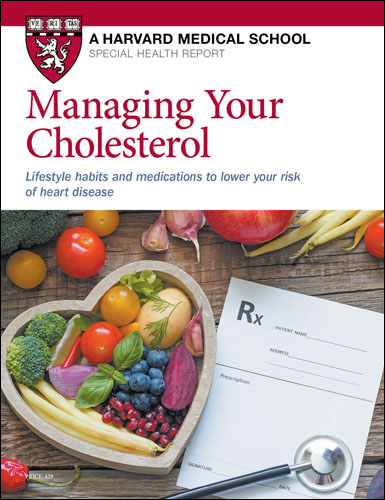Expand your healthy cooking oil choices
Peanut, walnut, sesame, and other oils keep meals interesting.

By now you know that a healthy diet should focus mostly on plants — vegetables, fruits, legumes, nuts, and seeds. The same applies to cooking fats: stick to oils extracted from plants, such as olive or canola. You don’t have to limit yourself to those two; there’s a whole garden of options that can add variety and flavor your meals.
What’s in plant oils?
Plant oils are made of fatty acids. A small portion is saturated fat — the kind that can raise LDL (bad) cholesterol. The rest is a combination of polyunsaturated fats (famous for lowering LDL) and monounsaturated fats (such as oleic acid), which may have some ability to increase HDL (good) cholesterol. Both types of healthy unsaturated fat help fight inflammation.
The ratio of polyunsaturated and monounsaturated fat varies among oils. For example, olive, avocado, and safflower oils are high in monounsaturated fats; corn and soybean oils are high in polyunsaturated fats.
Some oils — such as soybean, canola, walnut, and flaxseed — are rich in a plant-based omega-3 fatty acid called alpha-linolenic acid (ALA), which may promote brain and heart health.
Which oil is healthiest?
The FDA allows oil makers to advertise the claim that daily consumption of oils containing 70% oleic acid, when substituted for oils high in saturated fat (like butter or coconut oil), may reduce the risk of heart disease. Similar health claims are allowed for soybean oil, because of its ALA content.
But you don’t need to consider a particular nutrient makeup when choosing a plant oil. "It’s not going to make a difference in terms of health, especially if you eat a healthy diet that includes nuts and fish; you’re already getting a mix of polyunsaturated and monounsaturated fats," says Teresa Fung, adjunct professor in the Department of Nutrition at the Harvard T.H. Chan School of Public Health.
Keep in mind, though: Plant oils are healthy fats, but like all fats, they’re high in calories. One gram of fat has more than twice the number of calories as one gram of carbohydrates or protein. For each tablespoon of olive or canola oil you’re getting about 120 calories per tablespoon, so calories can add up quickly.
Cooking stability
One thing that differentiates various plant oils is their stability when used in cooking.
High heat causes molecules in oils to break apart, burn, become bitter, lose nutrients, and release smoke. Most oils have a "smoke point" between 400° and 500°. "You won’t reach that point unless you are heating oil very high to deep-fry food. You lose the oil’s health benefit when the high temperature breaks down fatty acids. Also, deep-fried foods absorb oil and add more calories to your meal," Fung says.
Sturdy oils good for sautéing, stir-frying, or roasting foods include avocado, canola, corn, grapeseed, regular or light olive oil (not virgin or extra-virgin), peanut, rice bran, safflower, soybean, and sunflower oils.
Oils that have a low smoke point can lose flavor and structure quickly at high heat, so they’re better for drizzling on food or using in a salad dressing. These include flaxseed oil, extra-virgin or virgin olive oil, certain nut oils (almond, hazelnut, macadamia, pistachio, or walnut), and sesame oil. "Sesame oil is fragile. When I grew up in Hong Kong and we’d make noodle soup, we’d add sesame oil on top just before we ate it — not during cooking. That way the oil retained its flavor," Fung says.
Understanding olive oilsOlive oil is high in antioxidants and monounsaturated fats. The oil comes in several grades. You can tell them apart only by their names.
|
When should you use each one?
The type of plant oil you use depends on the dish and your preference. Some cuisines rely on certain oil flavors. For example, use
- almond, peanut, or sesame oil in Asian food
- olive or sesame oil in Middle Eastern food
- olive oil in Mediterranean food.
If you want a neutral oil that won’t overpower food, use avocado, canola, grapeseed, safflower, or sunflower oil. For a stronger flavor, try flaxseed or nut oil. A good way to experiment: try various oils in a salad or on bread.
Image: © WillSelarep/Getty Images
About the Author

Heidi Godman, Executive Editor, Harvard Health Letter
Disclaimer:
As a service to our readers, Harvard Health Publishing provides access to our library of archived content. Please note the date of last review or update on all articles.
No content on this site, regardless of date, should ever be used as a substitute for direct medical advice from your doctor or other qualified clinician.
















